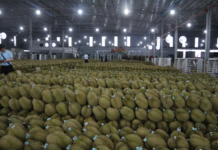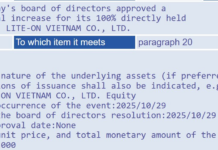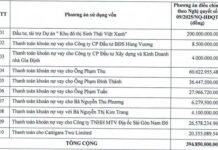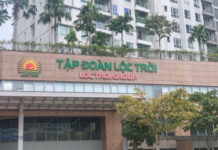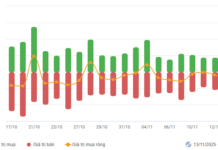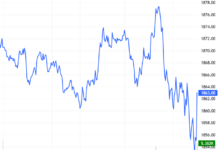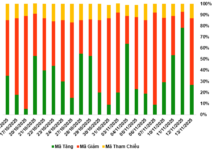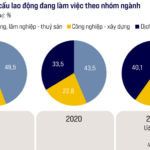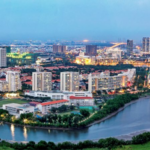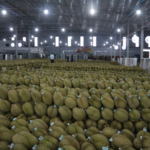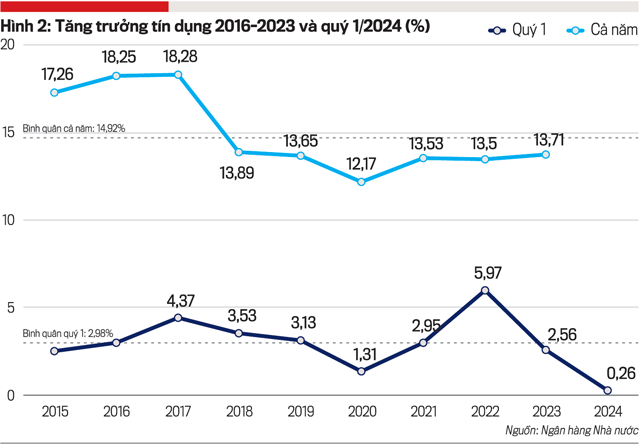The structures mentioned here include several key structures such as the economic sector structure, the economic type structure, the regional economic structure, and some detailed structures, which are internal/external factors, labor, investment capital, enterprises, revenue and expenditure, budget, etc.
ECONOMIC SECTOR STRUCTURE
Just a few words, “Agriculture is the foremost front, and food is the top priority,” contributed to Vietnam’s escape from a severe crisis, latent from the late 1970s to the early 1990s of the 20th century. This crisis was characterized by low growth, a per capita GDP of $86 in 1988, placing Vietnam among the lowest in the world, hyperinflation, and high unemployment – an economy with a large deficit.
The proportion of the agricultural, forestry, and fisheries group decreased
After basically overcoming the crisis, especially after 20 years, in 2008, Vietnam transitioned to a middle-income country, entering the period of industrialization and modernization with the goal of becoming an industrialized country, surpassing the lower-middle-income threshold…
Accordingly, the decrease in the proportion of GDP of the agricultural, forestry, and fisheries group is the right direction in the process of industrialization and modernization and the transition from an agricultural to an industrial country. In 2022, among the countries and territories with comparable data, the proportion of this group in Vietnam’s GDP was still the 4th highest in Southeast Asia, 21st in Asia, and 34th in the world.
This process also contributes to the increase in the proportion of the industry-construction group in GDP. However, this proportion is still low (5th in Southeast Asia, 11th in Asia, and 17th in the world).
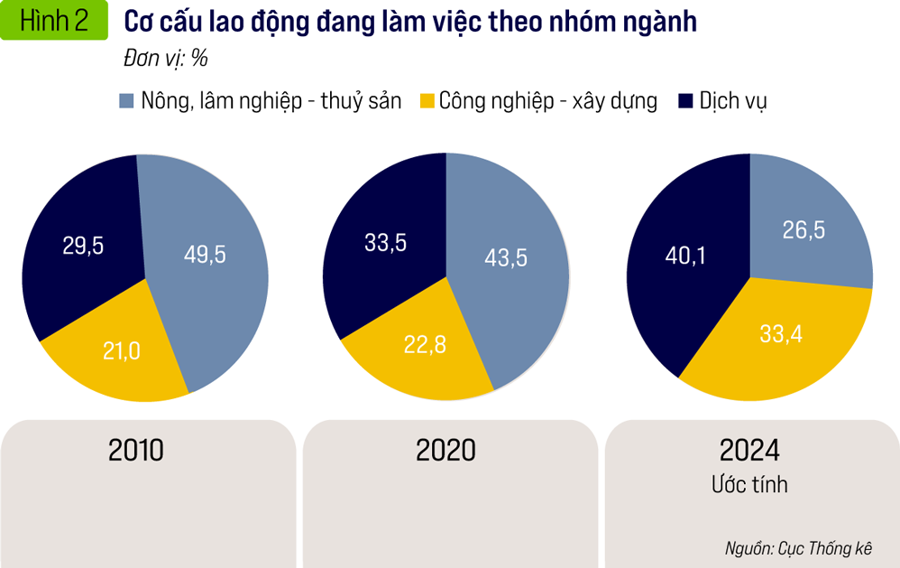
For a country in transition with a large degree of openness, although the proportion of the real economy is larger than that of the service economy, the proportion of Vietnam’s real economy is still low. The proportion of the service economy is increasing and accounts for the largest proportion of the three groups; although it is necessary in the long run, it is still low compared to many countries and territories with comparable data (6th in Southeast Asia, 24th in Asia, and 90th in the world).
Notably, the sectoral shift in some localities needs to be considered: the proportion of services in large cities is still low, while industry and construction are high (but the proportion of clean and high-tech industries is not large); some areas suitable for agricultural, forestry, and fisheries development also prioritize industry…
The economic structure has shifted due to various factors, including shifts in labor and investment capital…
The labor structure by sector has shifted positively. The proportion of agricultural, forestry, and fisheries labor has decreased to shift to industry, construction, and services to increase labor productivity and income compared to working in the agricultural, forestry, and fisheries sector.
In the past, labor in the agricultural, forestry, and fisheries group moving to cities to work in industry and services was positive, but now there are messy “labor markets.” Currently, many industrial and service enterprises have moved to rural areas, attracting agricultural labor to follow the “leaving agriculture but not the countryside” method, which has a dual impact. It not only shifts the labor structure by sector but also increases the urban population.
Many service activities that used to be associated with agencies and enterprises are now separate, so professionalism is higher, and service labor productivity is higher. However, due to the weakness of auxiliary industries and the large proportion of assembly, income is low and dependent on imports (Figure 3)
The investment capital for new rural construction has contributed to changing the rural face, especially in terms of roads, alleys, and hamlets. However, the proportion of investment capital in agriculture, forestry, and fisheries is still far lower than the proportion in GDP and the number of laborers working in this group, causing the growth rate of GDP and many indicators (such as the rate of trained laborers, labor productivity,…) in agriculture and rural areas to be still low, while other indicators (such as the poverty rate) are much higher than in urban areas.
The proportion of GDP in agriculture, forestry, and fisheries tends to decrease, which is appropriate and correct after overcoming “instability without agriculture.” When many types of agricultural, forestry, and aquatic products are sufficient for domestic use and export in large quantities, ranking high in the world,… Then, we must realize that “without industry, there is no wealth,” and switch to industry to get rich, and realize “without commerce, there is no activity” (in a broad sense, including services) to ensure dynamism and flexibility in the market economy…
However, Vietnam started as an agricultural country, with climatic and land advantages, favorable for agriculture development,… while the surrounding countries have a large population and are rapidly shifting to industry and services. Vietnam is also predicted to be one of the few countries most affected by climate change and sea-level rise.
The proportion of the rural population is large, the country’s population has exceeded 100 million people, and it still increases by nearly 1 million people every year; the proportion of agricultural, forestry, and fisheries labor is still high. The proportion of total social investment capital in agriculture, forestry, and fisheries is decreasing and is still far lower than the proportion in GDP, labor force…
The proportion of high-tech agriculture is still low; processing to increase the value of agricultural products is still low. For many plants and animals, many years, and many regions are still in the state of “making a profit by working hard”,… Therefore, it is necessary to consider industrialization and modernization of agriculture, forestry, and fisheries as an important goal.
The proportion of the industry-construction sector increased
The proportion of GDP in industry and construction tends to increase, which is appropriate and correct. This result is achieved due to the shift in labor structure, investment capital, the rate of trained laborers, the proportion of exports,… of industry and construction. Notably, the proportion of processing and manufacturing industry (the main criterion of an industrialized country) in many indicators increased, with the proportion in GDP in 2024 exceeding 24%. The continuous increase in the urban population during this period also contributed to the development of industry, construction, and services.
However, there are three limitations in industry and construction that need to be addressed promptly. Supporting industries have been proposed for a long time but are still weak. The situation of assembly and processing is still large, even for some industries in the foreign-invested sector; this situation has a significant impact on the income of laborers and enterprises and on dependence on foreign countries through imports…
The foreign-invested sector accounts for a large proportion of industrial production value, not only affecting the export market share but also occupying a part of the domestic consumption market share. There are many reasons for this situation, including limitations in the spillover between the foreign-invested sector and the domestic sector.
The proportion of the service sector has developed faster
The proportion of GDP in the service sector has developed faster than the real economy (including agriculture, forestry, fisheries, and industry-construction) is appropriate and correct. This includes the rapid development of transport warehousing, tourism, trade,… related to logistics, the digital economy,… which is necessary. But the real economy is more “resilient” than the service economy when there are fluctuations in the world economic-financial-monetary situation,… While the number of service enterprises and the number of people working in the service sector in Vietnam are large, the scale of capital is small, scattered, and the international competitiveness is very weak…
ECONOMIC TYPE STRUCTURE
The economic type structure has the specificity of a transitional economy like Vietnam, but it also significantly affects the exploitation of social resources and the market nature of the economy. The structure and shift of Vietnam’s GDP structure by economic type in the past time are as follows (Figure 4):
The economic type structure is not only a shift in GDP structure but also a shift in the structure of labor, investment capital, and the shift in the enterprise sector.
The outstanding result of the shift in the economic type structure is the decrease in the proportion of the state economic sector, the increase in the proportion of the non-state economic sector, and the increase in the proportion of the foreign-invested sector, the market nature of the economy increases,…
The state economic sector, although reduced in proportion, still plays an important role in forming key projects of the country, especially in security and defense, infrastructure; investing in regions and fields that other sectors are not allowed or do not want to invest in, is a source of “seed capital” for other sectors to invest in…
However, many proportions of this sector are still high, the administrative apparatus is still cumbersome, the market nature of the economy is not extensive, and the state still holds many direct production and business fields, and the fields of law and mechanisms are slow to be improved. The operation of state-owned enterprises is not yet effective, as the proportion of net revenue, total income is lower than the proportion of operating capital, fixed assets, and long-term financial investment. The proportion of total income and pre-tax profit in 2022 decreased compared to 2010…
The non-state economic sector increased in many proportions, contributing to the increase in the overall market nature. However, the proportion of net revenue, total income, especially pre-tax profit, is lower than the proportions of operating capital, fixed assets, and long-term financial investment. The proportion of private economy is small and has hardly increased over the years, while this is the part that needs attention because the private economy is honored as the driving force of growth.
The number of business owners in 2023 decreased compared to 2010 (from 1,687,900 to 669,500). The proportion of the total number of laborers decreased (from 4.14% to 2.09%). The number of large private enterprises has appeared on the list of USD billionaires or the number of people with assets of millions of USD has increased, but the number of enterprises exiting the market is quite large and high (in 2024, 100,098 enterprises temporarily ceased operations, up 12.4%; 78,155 enterprises temporarily ceased operations waiting for dissolution, up 16.3%; 21,608 enterprises completed dissolution procedures, up 20%; a total of 197,861 enterprises, up 11.4%).
The foreign-invested sector accounts for a large proportion of industrial production (about 50%), a very large proportion of exports (about 72%), and an increasing proportion of labor and investment capital. From 2025, these proportions are expected to increase even faster, as a large amount of capital, concentrated in high technology, will be transferred to Vietnam to avoid taxes when exporting to the US…
REGIONAL ECONOMIC STRUCTURE
According to data published by the General Statistics Office, among the 10 localities with the largest GRDP in 2023, Ho Chi Minh City ranked first (VND 1,613 thousand billion), followed by Hanoi (VND 1,291 thousand billion), Dong Nai (VND 449 thousand billion), Binh Duong (VND 447.2 thousand billion), Ba Ria – Vung Tau (VND 410.2 thousand billion), Hai Phong (VND 395.5 thousand billion), Quang Ninh (VND 313.7 thousand billion), Thanh Hoa (VND 276.7 thousand billion), Bac Ninh (VND 225 thousand billion), and Hai Duong (VND 187.5 thousand billion).
The above 10 localities had a total GRDP of VND 5,608.8 thousand billion in 2023, accounting for more than 54% of the country, much higher than the population proportion of 35.8%, far exceeding the area proportion, accounting for 42% of FDI registered, 65.5% of exports,… This means that in addition to favorable locations, good infrastructure, many operating enterprises, and a leadership team with a vision,… there are also positive results in attracting FDI, the number of operating enterprises, export turnover, and a reasonable economic structure…
Regarding GRDP per capita in 2023, among the 10 localities with the highest GRDP per capita in the country, Ba Ria – Vung Tau ranked first with VND 345.4 million/person, followed by Quang Ninh with VND 227.1 million/person, Hai Phong with VND 187.9 million/person, Ho Chi Minh City with VND 170.6 million/person, Binh Duong with VND 169 million/person, Hanoi with VND 150.3 million/person, Bac Ninh with VND 148.3 million/person, Dong Nai with VND 135.6 million/person, Vinh Phuc with VND 130 million/person, and Thai Nguyen with VND 115.1 million/person.
Notably, Thai Nguyen province – a province in the Northern Midlands and Mountainous region – is on this list thanks to its large FDI and export turnover. Two other small provinces, Bac Ninh and Vinh Phuc, are on this list thanks to their large FDI, developed industry, and large export turnover.
Ho Chi Minh City and Hanoi have many advantages and strengths in terms of geographical location, infrastructure, organizational apparatus,… but only ranked 6th and 7th. The other centrally-run cities, Da Nang and Can Tho, are not among the 10 localities with the highest GRDP per capita in the country, ranking only 12th and 16th in the country.
In addition, the 10 localities with the lowest GRDP per capita in 2023 are: Ha Giang with the lowest level (VND 35.6 million/person), followed by Cao Bang with VND 41.2 million/person, Dien Bien with VND 43.4 million/person, Yen Bai with VND 50.9 million/person, Son La with VND 51 million/person, Bac Kan with VND 51.7 million/person. Ben Tre VND 52 million/person, Lai Chau VND 52.2 million/person, Nam Dinh VND 52.3 million/person, Nghe An VND 56 million/person…
The article was published in the special edition of Economics 2024-2025: Vietnam & The World, published in February 2025. Please refer to it here: https://postenp.phaha.vn/tap-chi-kinh-te-viet-nam/detail/1262
The Evolution of Structural Dynamics
“Development is often likened to ‘running and queuing simultaneously’. Speed is represented as ‘running’, while structure is likened to ‘queuing’. Queuing is fundamental and long-term; it not only affects the running speed but also impacts various states of stability and crisis, agriculture or industrialization, market-oriented or non-market-oriented economy, and so on. Given its significance, structure and structural transformation deserve more attention.”
“VN-Index to End 2025 at a Modest 1,550 Points: Experts Highlight Two Attractive Options for Risk-Taking Investors”
For the intrepid investor, there are opportunities to be found in cyclical sectors and markets such as equities that benefit from cash flow, new product launches, and market upgrades. The tech sector is also a key area to consider, with long-term gains to be made from Resolution 57 on innovation, AI, semiconductors, and digital data.
“Vietnam’s FDI Appeal Remains Unshaken by Tariff Turbulence”
Although the US administration has tweaked some tax policies amid escalating trade tensions with China, foreign direct investment (FDI) into Vietnam, particularly in high-tech and ancillary industries, has not witnessed significant changes. Experts attribute this stability to Vietnam’s enduring competitive advantage in the global supply chain, which transcends the short-term effects of international tax policies.


